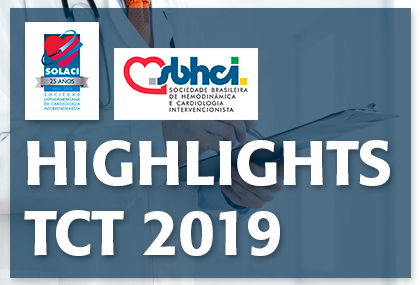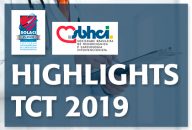Courtesy of the SBHCI. Discover the results of the this study, presented during TCT Congress 2019. Link to the SBHCI publication HERE Original Title: A Propensity Score-Matched Analysis of Transcatheter Tricuspid Valve Treatment vs. Medical Treatment in Patients With Severe Tricuspid Regurgitation. Author of the original title: Maurizio Taramasso. We are interested in your opinion. Please,…
TCT 2019 | Mitral Valve-in-Valve: 1-Year Results for Sapien 3 in Mitral Valve Replacement for Degenerated Bioprostheses
Courtesy of SBHCI. The aim of this work was to assess the contemporary outcomes of mitral valve-in-valve using Sapien 3 prostheses, see the differences between trasapical and transseptal access, and establish 1-year mortality predictors. Researchers analyzed retrospectively the data from the Society of Thoracic Surgeons [STS]/American College of Cardiology TVT Registry, which included 1576 patients who had…
TCT 2019 | STS/ACC TVT Registry: Relationship Between MitraClip Operator Experience and Events
Courtesy of SBHCI. Mitral valve repair with a MitraClip device is a complex procedure that requires that operators develop a series of skills that may be unusual for them, such as analyzing an echocardiography. In this registry, researchers assessed the relationship between operator experience and procedural outcome. Operators were classified into 3 groups: 1 to 25 procedures…
TCT 2019 | PARTNER 3 Low-Risk Computed Tomography Substudy: Subclinical Leaflet Thrombosis in Transcatheter and Surgical Bioprosthetic Valves
Courtesy of the SBHCI. Discover the results of the PARTNER 3 study, presented during TCT Congress 2019. Link to the SBHCI publication HERE Original Title: PARTNER 3 Low-Risk Computed Tomography Substudy: Subclinical Leaflet Thrombosis in Transcatheter and Surgical Bioprosthetic Valves. Author of the original title: Raj Makkar. We are interested in your opinion. Please,…
TCT 2019 | PORTICO: This vs. Any Other Valve Available in the Market
Courtesy of SBHCI. This work, presented at the TCT 2019 Scientific Sessions, showed the 30-day safety and 1-year efficacy of self-expanding prosthesis Portico compared with all valves approved by the US Food and Drug Administration (FDA) for the treatment of patients with severe aortic stenosis and high surgical risk. Between 2014 and 2019, researchers enrolled 750 patients…
TCT 2019 | SCOPE I: Self-Expanding Valve Acurate Neo Head to Head with Sapien 3
Courtesy of SBHCI. This work, which was presented during the TCT 2019 Scientific Sessions and simultaneously published in the Lancet, randomized patients to the ACURATE Neo prosthesis (n = 373) vs. the SAPIEN 3 (n = 367) in a head-to-head comparison involving 20 European sites. Transfemoral access was used in all patients. The study had a noninferiority design, and its primary…
TCT 2019 | MODEL U-SES: More Devices for High Risk of Bleeding and Short DAPT
Courtesy of SBHCI. This study tested the safety of dual antiplatelet therapy (DAPT) after only three months of bioresorbable polymer sirolimus DES implantation (Ultimaster). Secondary end point was following with P2Y12 inhibitor monotherapy after the first 3 months compared with aspirin. It included 1695 patients treated with sirolimus eluting Ultimaster receiving 3-month DAPT. After the…
TCT 2019 | EVOLVE Short DAPT: Only 3-month DATP in High Risk Bleeding
Courtesy of the SBHCI. This study used the thin strut everolimus eluting stent with ultrathin abluminal bioresorbable polymer coating chromium platinum stent, basically the Synergy stent. Drug release and polymer degradation within four months facilitate endothelization and would allow a shorter DAPT. Presented during the scientific sessions of TCT 2019, this study included 2009 high…
TCT 2019 | AUGUSTUS ACS: Apixaban vs. Warfarin and Aspirin vs. Placebo in AF and ACS
Courtesy of SBHCI. The safety and efficacy of antithrombotic and antiplatelet treatments in patients with atrial fibrillation admitted with acute coronary syndrome (who receive medical treatment or angioplasty) may vary from that in patients undergoing elective treatment. At 14 days from elective angioplasty or hospitalization due to acute coronary syndrome, patients were randomized in a 2×2…
TCT 2019 | IDEAL-LM: Bioabsorbable Polymer DES vs. Permanent Polymer DES for Left Main Stenosis
Courtesy of SBHCI. This study showed that using the everolimus eluting stent with bioabsorbable polymer Synergy followed by 4 months of dual antiplatelet therapy (DAPT) to treat left main stenosis (LMS) was safe and effective, compared against using the everolimus eluting stent with permanent polymer Xience followed by the conventional 12 months DAPT. This study…
TCT 2019 | Onyx ONE: Durable Polymer vs. Polymer-Free Stent with Only One Month of Dual Antiplatelet Therapy
Courtesy of the SBHCI. This is the first randomized study comparing a durable-polymer drug-eluting stent (zotarolimus-eluting stent Onyx) and a polymer-free drug-eluting stent (biolimus-A9-coated stent BioFreedom), with only one month of dual antiplatelet therapy in patients at high risk for bleeding. Onyx ONE was a study conducted at 84 sites that randomized 1:1 2000 total patients at…

